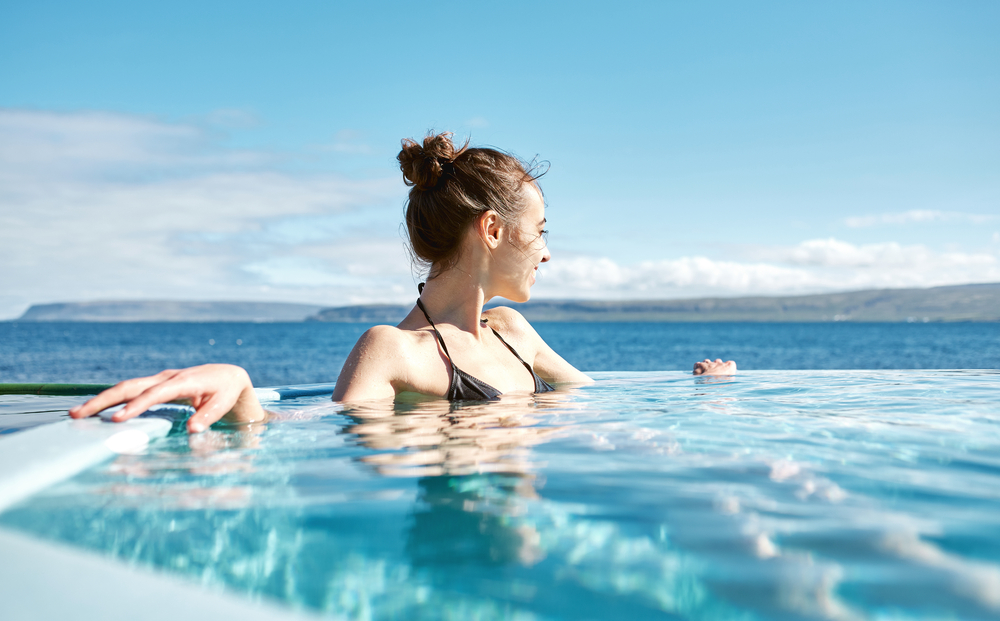Welcome to our special section, Thrive on Campus, devoted to covering the urgent issue of mental health among college and university students from all angles. If you are a college student, we invite you to apply to be an Editor-at-Large, or to simply contribute (please tag your pieces ThriveOnCampus). We welcome faculty, clinicians, and graduates to contribute as well. Read more here.
An eager flock of 20 or so 7-year-old girls raided the shower room, buck naked — just the wake-up call I asked for amidst Reykjavik’s complete 11 a.m. darkness. My mom and I clutched our towels, meekly following the girls’ procedures in the changing room: a meticulously carried-out sequence before they crossed the threshold to the outdoor swimming area, tough-skinned and fearless as their Viking ancestors.
“No, absolutely not,” my mom said through gritted teeth, shivering in her coral swimsuit and flip-flops, “I’m not going out there.”
Still jet-lagged and flabbergasted that it was mid-day but felt nothing like it, I made a weak argument as to why we should go outside. We were in Reykjavik, Iceland, after all, and surely that meant we had to try the city’s signature sport: swimming. Also, 20 7-year-old girls just braved the biting cold in kiddie bikinis. What did it say about our courage if we couldn’t?
So we ran outside with a self-destructive mentality, jumping into the shallow pool one after the other, greeted by a spouting mushroom fountain. The water was lukewarm heaven. The gargantuan task was over. We melted into bliss.
My mom and I chose to come to the pool — Sundhollin — after randomly spotting it on our hotel-issued map. Opened in 1937, it boasts the title of Reykjavik’s oldest swimming pool, a cloistered establishment similar to an ancient Roman bathhouse. In order to swim there, you have to know about Sundhollin’s very existence: a fact that locals are proud of, hence giving vague directions to tourists along the lines of, “It’s behind the big church, just walk straight and you’ll find it eventually.”
While this pool is quite popular due to its central location and extensive history, Reykjavik flaunts other public baths like Seltjarnarneslaug, Lagafellslaug and Vesturbaejarlaug, many of which evoke Ibiza-esque party scenes (adult water slides and unicorn floats included). Sundhollin, however, is manageable and quaint, especially on dark mornings when one might need a little extra help re-energizing. Its Art Deco design and bright pops of color in the changing rooms are quite literally eye-opening.
For Icelanders, swimming in pools is a deeply imbedded virtue. It dates back to 12th century settlement, when Snorri Sturluson, a politician with a flare for the ingenious, decided to build himself a thermal pool as an antidote to the frightening realities of Iceland’s weather. The premise was embraced instantaneously, nurtured ever since by the country’s geothermal energy supply drilled from the layers of earth beneath Iceland’s volcanoes. In 1943, swimming even became considered part of school curriculum, just as serious a subject as math or Icelandic history.
After swimming for just half an hour in the cool, back-lit lap pool, it wasn’t hard to see that swimming serves Iceland well in terms of boosting its already impressive happiness index. The World Happiness Report gave Iceland a score of 7.49 (out of 10) in 2019, making it a happy country by any standard.
I can only imagine what benefit the combination of this bodily relaxation and daily socialization provides to Icelanders on a daily basis. For them —unlike in the U.S., where swimming is a lonely undertaking akin to meditation — swimming pools are a way to catch up on life with friends, as well as a way to meet new ones. Nothing bonds people like seeing each other half-naked.
Because I have not yet mastered the art of being present, even in this environment of Zen, my thoughts traveled back home. We swim, all right — there are swim teams, swim groups and even in-water aerobics classes. But these activities function as accessories, even electives. Maybe if we took after the Speedo-clad, breaststroke-performing Icelanders in treating swimming (and the socialization it entails) as something essential and celebrated, we would benefit in the long run.
On the last day of our trip, my mom and I went back to Sundhollin, knowing it would give just the perfect dose of pre-flight exercise and invigoration before we were to make the five-hour journey home. I would probably go swimming again in a few days, back in the States, but it would never match this particular swimming which was laid-back yet purposeful, equal parts thrilling and completely comforting.
As we were finishing up in the lap pool, I couldn’t make myself leave. It was as if by leaving this pool behind the big church, I was leaving all of Iceland’s big-hearted and value-driven people.
So I decided to swim one more time. Just one more lap for the Icelanders.
This article was originally published by The Baltimore Sun.
Subscribe here for all the latest news on how you can keep Thriving.
More on Mental Health on Campus:
What Campus Mental Health Centers Are Doing to Keep Up With Student Need
If You’re a Student Who’s Struggling With Mental Health, These 7 Tips Will Help
The Hidden Stress of RAs in the Student Mental Health Crisis


